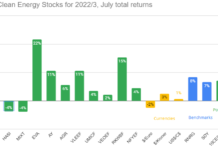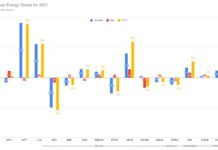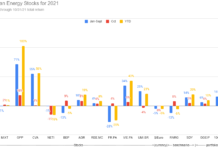Charles Morand
Last week, I added a little to my position in AAER (AAERF.PK). I first took a long position in AAER, the Canadian-based MW-size wind turbine maker, over two years ago. I’ve since pared down it significantly, both because I wanted to take some profit after a meteoric rise in share price in Q4 2007 and later because of the company’s seeming inability to get orders for more than a couple of turbines at a time.
Although there was, before the credit crisis hit, a severe shortage of wind turbines and wind turbine components, barriers to entry have remained high: (1) average order size has been growing and scale is becoming more critical; and (2) quality considerations are top-of-mind for funders as defective machines can throw off project economics. Both factors play against small emerging turbine makers with no quality records to show for. Getting a first large order has thus been the key milestone investors in AAER have been waiting for.
Finally, last October, as global markets were in the eye of the storm, AAER reached an agreement with a mid-size Canadian independent power producer, Northland Power, for 61 1.65 MW turbines for a total order size of 100.65 MW. This contract is valued at approximately C$142 million (~$152 million or $~1.5 million/MW) by the company and is structured as a cost-plus agreement, meaning that AAER is guaranteed to recoup its costs and earn a profit on the deal. However, the agreement was only that – an agreement – with a formal contract to be signed when both parties met a number of conditions. After being pushed back twice, this moment came on May 9 when the turbine supply agreement was finalized and signed…sorta. The contract is subject to a "notice to proceed" by the developer contingent "on final permitting, approvals and financing [being] obtained by both parties."
This could mean that Northland is having difficulty securing financing on acceptable terms. It could also mean that Northland anticipates permitting delays – a previous project not too far from this one was delayed by two years because of permitting hold-ups – and doesn’t want to commit before it’s certain it can get the regulatory green light. It could also mean nothing – according to the contract Northland signed with Hydro-Quebec, the utility buying the power, the developer is not required to show proof that it has secured financing until June 2010, so Northland might want to wait for credit markets to ease out a bit. However, with a contractual deadline obligating Northland to start producing power by December 2010 (failing which the developer must pay a penalty of C$55 per MW per day up to a max of C$2.01 million), the order will have to be initiated soon if the turbines are to be delivered on time.
In the clearest indication yet that the market’s risk appetite is far from back, the stock finished the week down over 15%. While investors are not yet pricing a worst-case scenario, it is fair to say that they feel overall very skittish about the apparent blanket option for the buyer to delay the turbine order as long as it pleases.
Last Friday (May 15), a glimmer of hope appeared after markets closed: AAER increased the size of an upcoming best effort unit offering – one unit is made up of one common share and one common share purchase warrant – from a minimum of C$2 million and a max of C$5 million, to a min of C$3 million and a max of C$7.5 million. Although small in absolute terms, this is an appreciable relative increase in the size of the offering of 50% at both tails. The company’s bankers, it seems, are seeing increased appetite for the stock.
I’m liking the contract and added a little to my position. My thesis behind this is two-fold: (1) if the notice to proceed is given within a reasonable time frame – and I believe that it could be – the share price could experience a nice pop, following which I would take a little profit; and (2) although this order falls well short of the plant’s theoretical capacity of 400 turbines per year (AAER has only 6 other turbines currently scheduled for delivery in 2009), it might just be enough to keep the firm alive through the end of the worst part of the credit freeze and until US renewable power policies kick-start the sector. Management has taken many of the right steps over the past two years and, with a large order in hand, the firm would be well positioned to fill the order book.
A Risky Bet
This is a risky play that essentially amounts to a bet on the Northland contract going through. If it doesn’t and AAER fails to secure another large order in the next few months, I would be very worried and would pull my money. This is why:
Liquidity: 2009 promises to be a punishing year liquidity-wise, with $14.9 million in contractual obligations and $9.5 million in payables and debt payments due. Meanwhile, AAER has a cash ratio of only 0.19 with C$2.6 million in cash and equivalents. This will be partly counterbalanced by cash coming through from a 2009 order book of around 9.65 MW (something in the neighborhood of $15 million), the money raised through the current unit offering and an unused line of credit worth $1 million. The liquidity crunch exists because AAER is in the process of tooling up its factory, purchasing inventory and paying off licensing fees to the companies from which it is licensing its turbine technologies.
Limited financing options: The credit crisis has made equity financing incredibly expensive for small alt energy companies – they are often forced to raise equity at a fraction of the price investors were willing to pay a year-and-half or two years ago. AAER is a prime example: it raised equity in November 2007 at $1.15 per share but, a year later in December 2008, had to do the same at $0.15. Investors typically don’t like dilution, and AAER won’t be able to optimize its capital structure by raising significant debt until it shows it can fill the order book. Eventually, too much dilution leads investors to bail, creating yet more pressure on the stock price and raising the cost of equity capital further. As at December 31, 2008, AAER had 122.4 million shares outstanding, a 48% jump on 2007.
The credit crisis: There is no doubt that the credit crisis has seriously shaken the renewable power sector. Perhaps ironically, the more mature technologies such as wind are amongst the hardest hit because of their relative capital intensity – the disappearance of tax equity investors coupled with the dearth of reasonably-priced debt has led to a marked slowdown in US wind installations. Many of the turbine majors have laid off employees in order to cut costs and reduce capacity. It will probably be a few more months before definite numbers to come out on the state of
the industry so far in 2009, but if anecdotes one hears at conferences or reads in the paper are any indication, it ain’t gonna be pretty! Needless to say, this is isn’t exactly the best time to try to turn a start-up into an established firm in an already-crowded industry struggling to cut capacity. Luckily, this situation will be short-lived.

UPDATE (May 22, 2009): The company just announced that it fully sold its unit offering (~C$7.5 million) and issued another C$1.5 million worth of units to “suppliers and other business partners”. This is positive news in my view as it indicates increased market appetite for the firm.
DISCLOSURE: Charles Morand is long AAER.








How is AAER doing now? It’s already mid-August and there’s no news on the Northland contract, just the most recent cryptic news release announcing a change of governance. Doesn’t sound promising, but I have only a small stake so I guess I’ll hang in, but I wish I could find more news.
AAER is not doing especially well. I came across two press releases that I found worrying:
1) Apparently they are not paying their sub-contractors and are getting sued as a result (http://www.energycurrent.com/index.php?id=3&storyid=19918) This is never good news and means they are trying to save cash on the backs of their suppliers and contractors – never good, this is something GM had gotten into the habit of doing
2) Another press report in the French (Quebec) media that claimed that they suspended all operations at the Bromont plant for the time being. I havent looked into whether or not that was true because even if it were I wouldn’t be suprised – in fact I might even be pleased
This company is getting seriously stretched cash-wise and is going to have to make something happen sooner rather than later. I’m not going to sell my position now because it is quite small and I still think that the Northland Power contract will come through – nothing currently indicates that it won’t.
But I also wouldn’t be surprised if they ran out of cash before that happens.